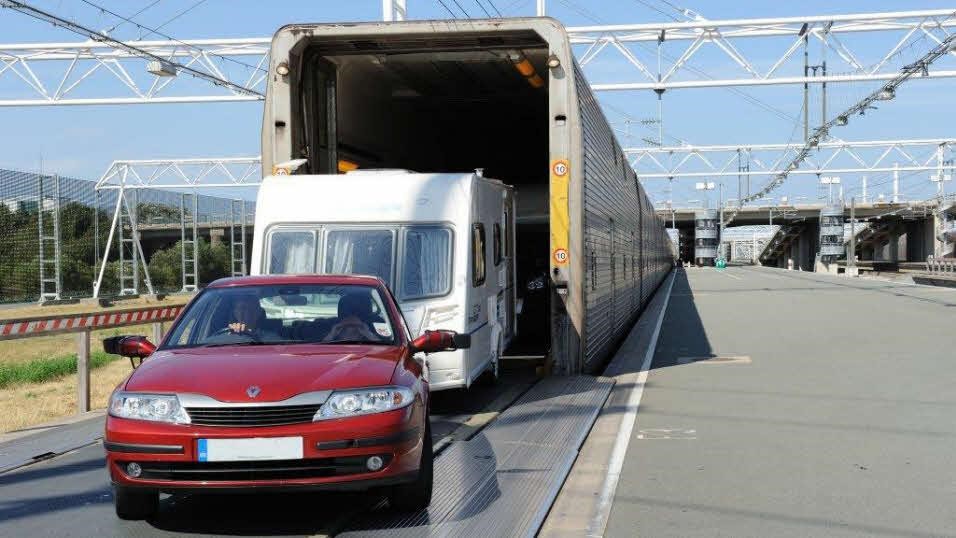 |
| ▲A Car is loaded on a train to go through the Eurotunnel in the UK. (Source:Caravan club UK) |
The Korea-Japan Undersea Tunnel is a project that connects the Korean Peninsula and Japan by building bridges and undersea tunnels from Busan City in Korea to Kyushu in Japan. The recent suggestion by a politician to make this Korea-Japan undersea tunnel is gaining interest.
The concept of the Korea-Japan undersea tunnel was first proposed during the Japanese colonial period. As Imperial Japan wanted to colonize the whole Asian continent, it needed the most efficient way to transport human resources and military supplies to and from the main continent of Asia which is more than 300kms away. The best way was to connect Japan and the Korean Peninsula to facilitate the expansion of Imperial Japan by occupying mainland China. But the plan fell through after the end of the imperial period.
In 1994, people witnessed the completion of European Channel Tunnel which connects the island nation of England to France in mainland Europe. The tunnel successfully transports goods and passengers and has had a great effect on the economy of both countries. Taking notes from the Eurotunnel, South Korea also examined the feasibility of the Korea-Japan undersea tunnel during the early 2000s, but it didn’t seem feasible due to security and technical issues. Even so, the Busan metropolitan government has continued to push for the Korea-Japan undersea tunnel.
If the project gets the green light, the tunnel will be 220 kms long which will be about 4 times the length of the current world’s longest bridge and tunnel connecting Hongkong, Macau, and mainland China. Fortunately, as Korea and Japan are both top ranked in terms of engineering and construction capabilities, and since both countries are financially stable, it is believed that both countries are more than capable of building and managing undersea tunnels.
In many cases, cities along the borders of countries around the world have become large and bustling cities thanks to active commercial activities. Cities such as Shenzhen next to Hongkong and Zhuhai next to Macau, have become some of the richest cities in China. And Johor, bordering Malaysia and Singapore is also one of the most prosperous cities in Malaysia. Similar to these cities, if Korea-Japan takes Free Trade Agreements with the undersea tunnel, there could be a number of good effects on the economy of Busan and Gyeongnam province as they become the gateway to the Korean Peninsula. The Japanese cities of Fukuoka and Kyushu would also benefit greatly from connecting two economic powers, and will become hubs of logistics and trade.
If the Korea-Japan undersea tunnel is built, there will be problems ventilating exhaust gas from the vehicles, and risks of fire and major car crashes. Adopting car hauler trains like in the Eurotunnel will be a solution for potential risks. Car hauler trains would also solve the road system differences between two countries. Unfortunately, unlike European and British railroad standards, Japan and Korea have different rail and train standards. Korea uses a 1435mm standard gauge rail, but Japan uses a 1067mm narrow gauge rail. Trains of both countries are not suitable for use in the other country.
Megaprojects like undersea tunnels between two countries can be undertaken when the both sides work together. Japan wants to overcome the disadvantages of being an island country, while South Korea hopes to increase its trade volume and economic profits. The positive effects on the economy and trading will occur as a result of making Trans-Eurasian continental travel possible. But in the case of South Korea, in many ways it is also an island country because North Korea separates South Korea from the rest of the Asian continent. From the Japanese point of view, it would be better to connect Hokkaido and Sahalin in Russia by building 50km of bridges or tunnels to travel via Russia to Europe instead of building over 200km of undersea tunnel to only trade with South Korea. If Japan decided to build a Russia-Japan direct bridge, the Korean Peninsula would be isolated from the European-Asian railway. South Korea would have to quickly come up with a way to connect South Korea to China, or to safely pass through North Korea.
The Construction of Korea-Japan undersea tunnel is considered to be a double-edged sword. It could boost economic growth by facilitating commercial activities, or it could be a waste of tons of money if the tunnel does not perform as well as expected. Authorities should carefully make a decision without any influence from anti-Japan groups. The Korean government should always be working to build relationships with neighboring countries to strengthen East Asian economic trading partnerships.
By Park Hyun-jong, reporter tommyhil4444@gmail.com
<저작권자 © The Campus Journal, 무단 전재 및 재배포 금지>

 Shrinkflation, Consumer Deception
Shrinkflation, Consumer Deception




